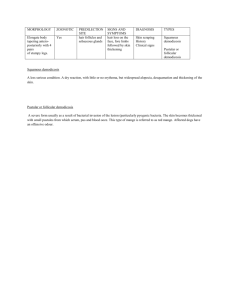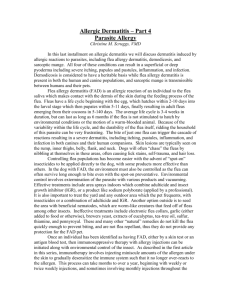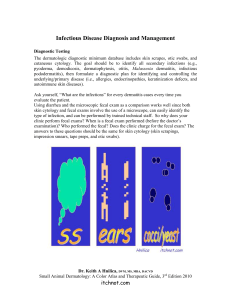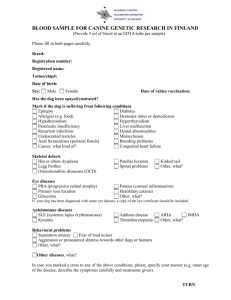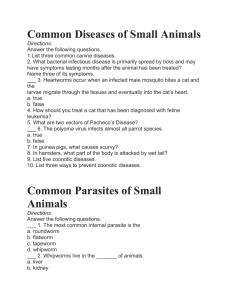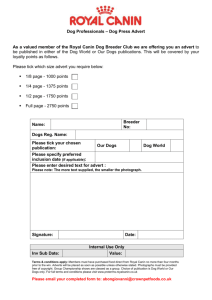Client Handout - Chippawa Animal Hospital
advertisement
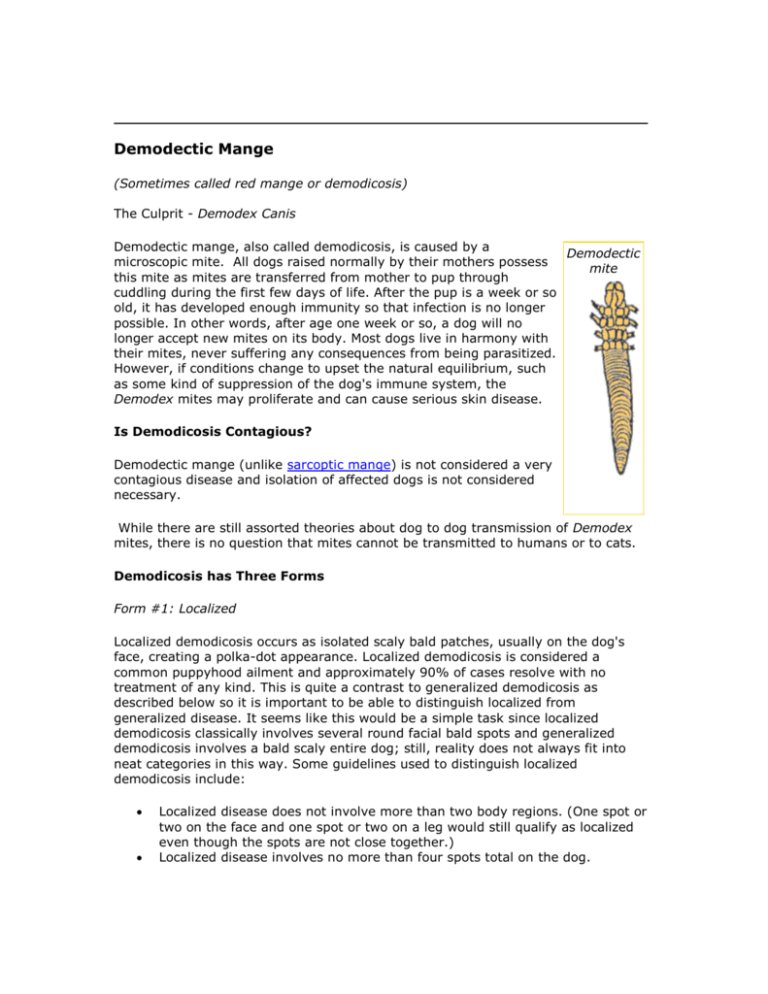
Demodectic Mange (Sometimes called red mange or demodicosis) The Culprit - Demodex Canis Demodectic mange, also called demodicosis, is caused by a Demodectic microscopic mite. All dogs raised normally by their mothers possess mite this mite as mites are transferred from mother to pup through cuddling during the first few days of life. After the pup is a week or so old, it has developed enough immunity so that infection is no longer possible. In other words, after age one week or so, a dog will no longer accept new mites on its body. Most dogs live in harmony with their mites, never suffering any consequences from being parasitized. However, if conditions change to upset the natural equilibrium, such as some kind of suppression of the dog's immune system, the Demodex mites may proliferate and can cause serious skin disease. Is Demodicosis Contagious? Demodectic mange (unlike sarcoptic mange) is not considered a very contagious disease and isolation of affected dogs is not considered necessary. While there are still assorted theories about dog to dog transmission of Demodex mites, there is no question that mites cannot be transmitted to humans or to cats. Demodicosis has Three Forms Form #1: Localized Localized demodicosis occurs as isolated scaly bald patches, usually on the dog's face, creating a polka-dot appearance. Localized demodicosis is considered a common puppyhood ailment and approximately 90% of cases resolve with no treatment of any kind. This is quite a contrast to generalized demodicosis as described below so it is important to be able to distinguish localized from generalized disease. It seems like this would be a simple task since localized demodicosis classically involves several round facial bald spots and generalized demodicosis involves a bald scaly entire dog; still, reality does not always fit into neat categories in this way. Some guidelines used to distinguish localized demodicosis include: Localized disease does not involve more than two body regions. (One spot or two on the face and one spot or two on a leg would still qualify as localized even though the spots are not close together.) Localized disease involves no more than four spots total on the dog. Treatment is not usually thought to be necessary for localized demodicosis but there may be cases where treatment should be considered. Resolution of a localized demodicosis lesion should be at least partially apparent after one month although total resolution can take up to three months. Approximately 10% of localized demodicosis cases will progress to generalized demodicosis. Enlarged lymph nodes are a bad sign, often foretelling generalized mange. Can the Pup be Bred Later? Puppy with localized demodicosis around her left eye Sometimes the puppy with localized demodicosis was obtained for breeding purposes. The current recommendation is not to treat these puppies so that we can determine if the condition will stay localized and resolve or if it will generalize. If it stays localized and eventually resolves without treatment, the animal is still a candidate for breeding. If the condition generalizes to cover the entire body, the animal should be spayed or neutered. If the condition receives treatment and resolves, we will never know how the disease would have gone in its natural state and will not know whether the pup is carrying a genetic predisposition for demodectic mange. In this case, it is best to be conservative and not take the chance of passing on genetic predisposition for this disease. Localized demodicosis is almost exclusively a puppyhood disease. When a puppy develops localized demodicosis, the chance of the condition resolving is 90% unless there is a family history of demodicosis in related dogs. In this case, chance of spontaneous resolution drops to 50%. Occasionally an adult dog develops localized demodicosis. We currently do not have a good understanding of the prognosis or significance of this condition in an adult dog. Form #2: Generalized Classically, with generalized demodicosis the entire dog is affected with patchy fur, skin infections, bald, scaly skin. Sometimes there are large patches of affected skin, and sometimes multiple "polka dots" of lesions cover the dog, and sometimes the entire body is involved. The secondary bacterial infections make this an itchy and often smelly skin disease. The approach to generalized demodicosis typically depends on the age at which the dog developed the disease. Adult Onset-- Most demodicosis occurs in young dogs, under one and a half years of age. An older dog should not get demodicosis unless he or she has an underlying problem with the immune system. In such cases, demodicosis is considered an indication to seek a more serious hidden condition such as cancer, liver or kidney disease, or an immune-suppressive hormone imbalance. A more extensive medical work-up will be required. Juvenile Onset -- Young dogs have inherently immature immune systems and are thus susceptible to the development of demodicosis without any sinister underlying diseases. As they grow up and their immune systems mature, they tend to naturally gain control of their mite infestation; in fact, 30-50% of dogs under one year of age recover spontaneously from generalized demodicosis without any form of treatment. Usually treatment is recommended, though, to facilitate recovery. IT IS IMPORTANT THAT DOGS WITH A HISTORY OF GENERALIZED DEMODECTIC MANGE NOT BE BRED AS THERE IS A HEREDITARY COMPONENT TO THE DEVELOPMENT OF THE DISEASE. Form #3: Demodectic Pododermatitis This condition represents demodectic mange confined to the paws. Bacterial infectious usually accompany this condition. Often as generalized demodicosis is treated, the foot is the last stronghold of the mite. Old English Sheepdogs and Shar peis tend to get severe forms of this condition. The infection can be so deep that biopsy is needed to find the mites and make the diagnosis. It is one of the most resistant forms of demodicosis. Treatment: Stress and Generalized Demodectic Mange The treatment of demodicosis only in part relies on medications; some basic steps can be taken with regard to pet care to maximize the chance of success. Physiological stress is an important factor determining the degree of severity of demodectic mange and the following steps should be taken to reduce stress: 1. Females should be spayed as soon as the disease is controlled. Coming into heat, hormone fluxes, and pregnancy are very stressful. Also, predisposition to demodicosis is hereditary and should not be passed on. 2. The dog should be fed a reputable brand of dog food so as to avoid any nutritionally related problems. 3. Keep the pet parasite-free. Worms are irritants that the pet need not deal with and fleas may exacerbate the itchiness and skin infection. 4. Keep up the pet's vaccinations. 5. The mites cause suppression of the immune system so the pet needs every advantage to stay healthy. 6. Skin infections are usually associated with these cases and antibiotics will likely be necessary. It is important that cortisone type medications such as prednisone NOT be used in these cases as they will tip the immune balance in favor of the mite. Treatment: Medications Current Treatment of Choice -- Ivermectin Ivermectin is a broad spectrum anti-parasite medication with a number of uses though its use in treating demodicosis is not approved by the FDA. It has been found that daily or every other day dosing is necessary for effective demodicosis treatment. Ivermectin is felt to be the drug of choice for this condition. Ivermectin is inexpensive relative to milbemycin (see below) and involves no labor intensive bathing. It DOES, unfortunately, taste terrible. There is also an important problem with regards to drug sensitivity in some individual dogs, which can even lead to death if they are given a typical therapeutic dose for demodicosis. THIS MEDICATION CANNOT BE ASSUMED SAFE FOR USE IN COLLIES, SHETLAND SHEEPDOGS, AUSTRALIAN SHEPHERDS, OLD ENGLISH SHEEPDOGS AND ANY HERDING BREED. Not all individuals of collie heritage are sensitive to ivermectin and a test is now available through Washington State University to determine whether an individual should be able to safely take ivermectin or not. An alternative to testing is to use a low test dose for a period of time and watch for mild side effects. If there is any question about your pet’s potential sensitivity to ivermectin, your veterinarian will instruct you. There is a range of ivermectin doses used in the treatment of demodicosis and it seems that higher doses do clear infection faster than lower doses. This means that if a lower dose has been ineffective, a higher dose may still work. This does not mean that pet owners should experiment with ivermectin doses on their own as there is some potential for lethal toxicity if this drug is not used appropriately. The high doses of ivermectin used in the treatment of demodicosis are not compatible with the flea product spinosad (Comfortis®). The combination of spinosad and high doses of ivermectin will increase the likelihood of neurologic side effects. While flea control is very important during the treatment of demodectic mange, a different product should be used. Traditional Treatment -- Amitraz (Mitaban) Dips Unless the animal is largely bald or has a short coat, complete clipping will be required for maximal contact with the dip. Dip should be preceded by a benzoyl peroxide bath to help clear up skin infections and open the hair follicles so the dip can penetrate to the mites. Shampoo must stay on the pet at least 10 minutes before rinsing. CAUTION: this type of shampoo can stain jewelry and clothing. Dip is applied by sponge. Gloves should be worn while applying dip. The dip dries on the dog's fur and should not be rinsed off. The dog should not get wet between dips. Dipping occasionally yields mild sedation as a side effect. Very small dogs may become highly sedated and require an antidote but this is unusual. For your convenience, dipping and bathing may be performed at the hospital thus allowing for veterinary supervision in the event of side effects. Dipping/bathing is recommended every two weeks according to the FDA approved label on the bottle of dip. Most universities are finding that the cure rate jumps from 25% to 80% when dip is used at double strength and applied weekly. No toxic effects have been seen using the dip in this way and this is our current recommendation when opting for dips except in very small dogs and puppies. Dipping is a fair alternative for ivermectin in collie breeds and in ivermectinsensitive individuals. AMITRAZ DIPPING SHOULD NOT BE USED IN TOY BREEDS OR IN YOUNG (UNDER 4 MONTHS OF AGE) PUPPIES. NOTE: Amitraz is a drug of the monoamine oxidase inhibitor class. People who are taking selected serotonin reuptake inhibitors (such as Prozac®) could have a bad reaction to the use of amitraz if they administer dips to pets. Human diabetics should also avoid administering amitraz dips. Interceptor® Interceptor (active ingredient: milbemycin oxime) is normally marketed as a monthly heartworm preventive; when it is used on a daily basis, it is effective against generalized demodicosis. This discovery was welcomed by the veterinary profession because demodicosis finally can be treated without labor intensive dipping or concern about ivermectin sensitivity. The downside to this treatment is expense, as Interceptor is typically sold in 6 dose packages and it is not uncommon for several months of treatment to be needed. INTERCEPTOR MAY BE USED IN ANY PATIENT SAFELY; THE ONLY DOWNSIDE IS EXPENSE. Prognosis The younger the dog, the better the chance of cure is. Most dogs less than one year and a half years of age recovery completely from generalized demodicosis. In many cases of adult-onset demodicosis, the disease is controlled with treatment but cure is not always possible. Some cases can never be controlled. Treatment, no matter which option is chosen, should be accompanied by skin scrapes every 2 weeks. In this way the effectiveness of treatment is assessed and modifications can be made. After two consecutive scrapes are negative, treatment is discontinued but a final scrape should be performed after one month off therapy. The reason for the final scrape is to be sure the mites are not coming back (which they can do if every single mite on the dog is not eradicated). Relapse? When relapse occurs it is often because the dog appeared to be normal and the owner did not return for the appropriate skin testing. Relapse is always a possibility with generalized demodicosis as there is no easy way to confirm that every mite has been killed, but most dogs that relapse do so within a 6 to 12 month period from the time they appear to have achieved cure. SARCOPTIC MANGE IS A COMPLETELY DIFFERENT DISEASE. We Wish it Wasn't Necessary to Add This Some 30 years ago, dipping dogs with demodectic mange in motor oil was a popular home remedy. Skin exposure to motor oil can cause rashes and skin destruction in severe cases. The hydrocarbons can be absorbed through the skin and cause a dangerous drop in blood pressure. If motor oil is licked off the coat, resultant vomiting can lead to aspiration of motor oil into the lungs and pneumonia. Kidney and liver damage can result from motor oil dipping. Please: Do not dip your dog in motor oil! No Motor Oil
